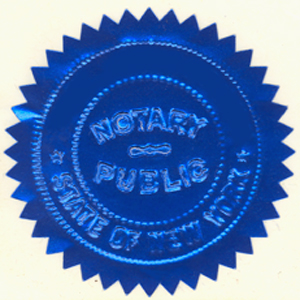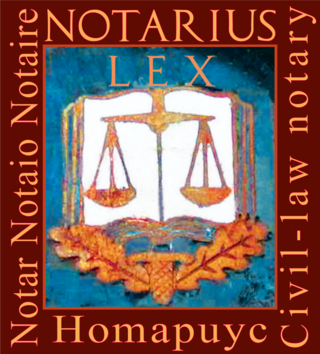An eschatocol, or closing protocol, is the final section of a legal or public document, which may include a formulaic sentence of appreciation; the attestation of those responsible for the document, which may be the author, writer, countersigner, principal parties involved, and witnesses to the enactment or the subscription; or both. [1] [2] It also expresses the context of the documentation of the action described therein, i. e., enunciation of the means of validation and indication of who is responsible to document the act; and the final formulae.
Common in European medieval charters, they have been relegated to notarial acts, governmental acts, diplomatic treaties, certificates, and other formal documents.
Eschatocols usually contain a:
In notarial writings, the eschatocol is specifically a long form of notarial authentication, i.e., the notarization proper, and takes the form of the final clause of acts in public form or of the certificate at the end of acts in private form, typically to certify the document for use in foreign states. The words of an eschatocol are very formulaic and vary depending on the nature of the notarial act. At least in English, much of what was previously several sentences is often condensed into one.
For acts in public form, typical eschatocols read as follows:
For those in private form, the following are typical:

An affidavit is a written statement voluntarily made by an affiant or deponent under an oath or affirmation which is administered by a person who is authorized to do so by law. Such a statement is witnessed as to the authenticity of the affiant's signature by a taker of oaths, such as a notary public or commissioner of oaths. An affidavit is a type of verified statement or showing, or containing a verification, meaning it is made under oath on penalty of perjury. It serves as evidence for its veracity and is required in court proceedings.

A notary public of the common law is a public officer constituted by law to serve the public in non-contentious matters usually concerned with general financial transactions, estates, deeds, powers-of-attorney, and foreign and international business. A notary's main functions are to validate the signature of a person ; administer oaths and affirmations; take affidavits and statutory declarations, including from witnesses; authenticate the execution of certain classes of documents; take acknowledgments ; provide notice of foreign drafts; provide exemplifications and notarial copies; and, to perform certain other official acts depending on the jurisdiction. Such transactions are known as notarial acts, or more commonly, notarizations. The term notary public only refers to common-law notaries and should not be confused with civil-law notaries.

Civil-law notaries, or Latin notaries, are lawyers of noncontentious private civil law who draft, take, and record legal instruments for private parties, provide legal advice and give attendance in person, and are vested as public officers with the authentication power of the State. As opposed to most notaries public, their common-law counterparts, civil-law notaries are highly trained, licensed practitioners providing a full range of regulated legal services, and whereas they hold a public office, they nonetheless operate usually—but not always—in private practice and are paid on a fee-for-service basis. They often receive generally the same education as attorneys at civil law with further specialized education but without qualifications in advocacy, procedural law, or the law of evidence, somewhat comparable to solicitor training in certain common-law countries.

A notary is a person authorised to perform acts in legal affairs, in particular witnessing signatures on documents. The form that the notarial profession takes varies with local legal systems.
A deed is a legal document that is signed and delivered, especially concerning the ownership of property or legal rights. Specifically, in common law, a deed is any legal instrument in writing which passes, affirms or confirms an interest, right, or property and that is signed, attested, delivered, and in some jurisdictions, sealed. It is commonly associated with transferring (conveyancing) title to property. The deed has a greater presumption of validity and is less rebuttable than an instrument signed by the party to the deed. A deed can be unilateral or bilateral. Deeds include conveyances, commissions, licenses, patents, diplomas, and conditionally powers of attorney if executed as deeds. The deed is the modern descendant of the medieval charter, and delivery is thought to symbolically replace the ancient ceremony of livery of seisin.

A holographic will, or olographic testament, is a will and testament which is a holographic document, meaning that it has been entirely handwritten and signed by the testator. Holographic wills have been treated differently by different jurisdictions throughout history. For example, some jurisdictions historically required that a holographic will had to be signed by witnesses attesting to the validity of the testator's signature and intent.

In the statutory law of wills and trusts, an attestation clause is a clause that is typically appended to a will, often just below the place of the testator's signature. It is often of the form signed, sealed, published, and declared, a legal quadruplet.

A certified copy is a copy of a primary document that has on it an endorsement or certificate that it is a true copy of the primary document. It does not certify that the primary document is genuine, only that it is a true copy of the primary document.
A commission is a formal document issued to appoint a named person to high office or as a commissioned officer in a territory's armed forces. A commission constitutes documentary authority that the person named is vested with the powers of that office and is empowered to execute official acts. A commission often takes the form of letters patent.

Notaries public in New York are commissioned by the Secretary of State of New York after passing a short examination in law and procedure and submitting an application for appointment accompanied by the proper fees. A notary's commission is received from and kept on file with the county clerk of the county in which they reside or do business, but notaries are empowered to actually perform their duties anywhere in the state.
A notary public in Virginia is authorized to acknowledge signatures, administer oaths, and certify copies On July 1, 2012, Virginia became the first state to authorize a signer to be in a remote location and have a document notarized electronically by an approved Virginia electronic notary using audio-visual conference technology by passing the bills SB 827 and HB 2318.
Presidential Proclamation 2714 was signed by President Harry S. Truman on December 31, 1946, to officially declare the cessation of all hostilities in World War II.
An eNotary is a Notary Public who notarizes documents electronically. One of the methods employed by eNotaries is the use of a digital signature and digital notary seal to notarize digital documents and validate with a digital certificate. Also known as remote online notarization (RON), electronic notarization is a process whereby a notary affixes an electronic signature and notary seal using a secure Public key to an electronic document. Once affixed to the electronic document, the document is rendered tamper evident such that unauthorized attempts to alter the document will be evident to relying parties. The e-notary will use cryptography and Public key infrastructure to create, manage, distribute, use, store, and revoke the digital certificate. E-Notary will improve the overall security of the closing process with improved customer file tracking and knowledge-based identification authentication, helping to reduce the frequency of errors or fraud. The Electronic Notary also must keep an electronic register of each act performed.
In the U.S. state of Florida, a notary public is a public officer appointed by the governor of the state to take acknowledgments, administer oaths, attest to photocopies of certain documents, solemnize marriage, protest the non-acceptance or non-payment of negotiable instruments, and perform other duties specified by law.
An act is an instrument that records a fact or something that has been said, done, or agreed. Acts generally take the form of legal instruments of writing that have probative value and executory force. They are usually accepted as self-authenticating demonstrative evidence in court proceedings, though with the precarious status of notaries public and their acts under common law, this is not always so.
The Treaty of Turkey Creek Prairie, unofficially called the Treaty of the Potawatomi, was signed March 26, 1836 between Mes-quaw-buck, a chief of the Potawatomi tribe of Native Americans, and the United States of America, represented by Abel C. Pepper. The accord originally contained six articles, with Article 6 stricken out by the Senate. The treaty ceded four sections of land on the Tippecanoe River, effective October 27, 1832. The United States paid the Chief and his band $2,560 "in specie at the next payment of annuity" once the treaty was ratified.
A jurat is a clause at the foot of an affidavit showing when, where, and before whom the actual oath was sworn or affirmation was made.
In the United States, a notary public is a person appointed by a state government, e.g., the governor, lieutenant governor, secretary of state, or in some cases the state legislature, and whose primary role is to serve the public as an impartial witness when important documents are signed. Since the notary is a state officer, a notary's duties may vary widely from state to state and in most cases, a notary is barred from acting outside his or her home state unless the notary has a commission there as well.

The Signing of the United States Constitution occurred on September 17, 1787, at Independence Hall in Philadelphia, Pennsylvania, when 39 delegates to the Constitutional Convention, representing 12 states, endorsed the Constitution created during the four-month-long convention. In addition to signatures, this endorsement, the Constitution's closing protocol, included a brief declaration that the delegates' work has been successfully completed and that those whose signatures appear on it subscribe to the final document. Included are, a statement pronouncing the document's adoption by the states present, a formulaic dating of its adoption, along with the signatures of those endorsing it. Additionally, the convention's secretary, William Jackson, added a note to verify four amendments made by hand to the final document, and signed the note to authenticate its validity.
A notarial act is any written narration of facts (recitals) drawn up by a notary, notary public or civil-law notary authenticated by the notary's signature and official seal and detailing a procedure which has been transacted by or before the notary in their official capacity. A notarial act is the only lawful means of proving those facts of which it is the recognized record, whereas on other matters it is usually inadmissible, because, being beyond the powers entrusted to the notary by law, it is non-official. In most common-law countries, multiple-page acts are bound together using a sewn or knotted ribbon, the ends of which are secured by a wafer impressed with the notary's seal. This is called annexing or annexure.
In a formal structure, intrinsic elements have three classes: protocol, text, and eschatocol. An example of eschatocol in private records is a sequence of appreciation sentence, salutation, complimentary clause (e. g., "sincerely yours"), signature, ...
The final part (eschatocol) could include subscriptio: signatures (mata) of the parties or stamps, sometimes the name of the scribe is also mentioned; apprecatio: blessings (e. g., śrīh., śubham, "hail"), authoritative confirmations (e. g., pramān ̇a) ...